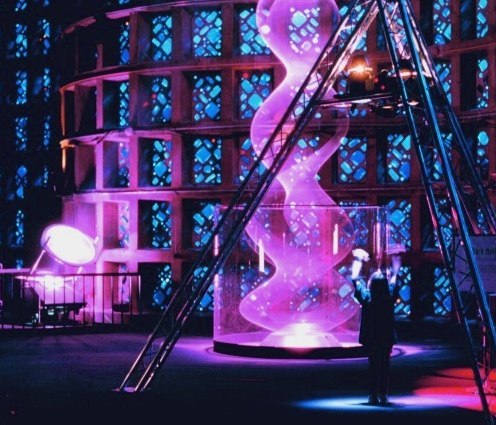
A child
waves her hand and a light sculpture responds. No illusions, this is real, Paul
Friedlander's DARK MATTER at...
New York Hall of Science
Lightforms '98
LIGHTFORMS
'98 is an international competition and exhibition. The three winning LightArt
proposals have been installed in the Great Hall of the New York Hall of Science,
April 16 - May 31, 1998.
Dark Matter is a 25 foot high, interactive, luminous dynamic light sculpture.
The fluid glowing waveform was suspended from the ninety foot high ceiling of
this extraordinary exhibition
space. Invisible
Soundbeams hidden in the pyramid like structure detect gestures and control
the sculpture.You can read the artists proposal here or look at The
Plans and Articles about it. The event was covered
by numerous papers and several magazines. Extracts from New Yorks Village Voice
and the British newspaper The Guardian are included here.

This will
not be the first exhibition of LightArt, but it will perhaps be, the first exhibition
of monumental, site-specific, and interactive LightArt in the world. This is
possible only because of the uniquely appropriate nature of the Great Hall.
To "feel" this space, imagine a blue, honey-combed cave, or gliding through
space leagues under the sea. Envision a cathedral-like space unfettered by the
visual interruption of vertical or horizontal support beams. No natural light
enters this darkened space, only that which is filtered by chunks of cobalt
blue glass embedded into cells in the strange curvilinear walls. The undulating
walls forms distinct "bays" in the oddly-shaped, 80' tall room. The exhibition
and competition is organised by ASCI, Art
and Science Collaboration, Inc. It was open from April 16 - May 31 1998. "Dark
Matter" received the "USHIO America Award for Innovation".

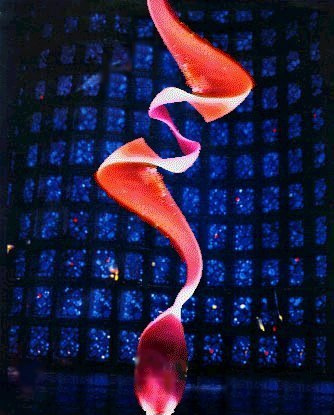 The winning entry from British light sculptor Paul Friedlander, Dark Matter,
was the culmination of many years work on a remarkable and relatively little
known discovery. Writing about it, he says
The winning entry from British light sculptor Paul Friedlander, Dark Matter,
was the culmination of many years work on a remarkable and relatively little
known discovery. Writing about it, he says
"The inspiration came from
a skipping rope. I illuminated the ghostly form created by the rope spinning
through the air. To my surprise and fascination, an electrically driven version
of this produced not just a simple envelope but a great variety of harmonic
and sometimes chaotic patterns.
I had discovered a frontier
of science and art, exploring a physical phenomena for artistic ends. Starting
with desk top sized works, I have extended the range and complexity of the pieces,
building installations with multiple ropes and computer controlled lighting
systems up to 6 metres high.
Integral to this work has
been the use of chromastrobic light. Chromastrobic light changes colour faster
than the eye can see. Persistance of vision causes rapidly moving objects to
leave multi-coloured trails floating in the air. "

Dark Matter

Imagine a search
light a billion billion billion times brighter than anything that now exists,
harnessing the power of a super nova *. If we could shine this light across
intergalactic space upon the vast mass of dark matter surrounding our galaxy,
what would be revealed? This remains the greatest mystery in science. We know
it is there but more than 90% of the mass in the universe is of a totally unknown
form.

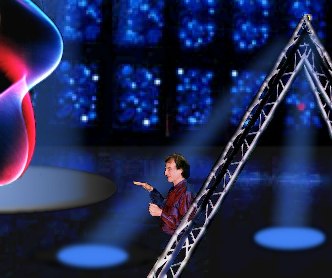
The
installation, Dark Matter, brings together the visible and the invisible. Visitors
interact with ultrasonic Soundbeams which detect the positions of their bodies
and even subtle hand gestures. As they move, a range of up to 64 different events
is triggered. The Soundbeams are mounted above head height on a 4 metre high
icosahedral framework. Visitors will be able to vary the speed of the rope and
the color of the light. One Soundbeam will control the speed of the rope. With
the other beam, an individual color can be selected or the colors set spinning
to provide chromastrobic illumination. Each Soundbeam uses a pulsed transducer
and a microphone to determine range from echo delay.
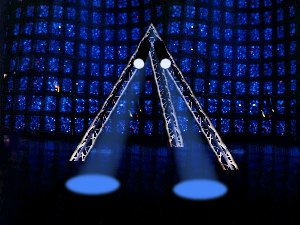 The Soundbeams are
positioned co-axially with beams of light to attract attention to their position.
They are fixed at 45 degrees to increase the variety of interaction. One visitor
may put his foot in the beam, another will walk right through at body height
and another will raise his hands in the air to catch the beam. Each will trigger
a different response.
The Soundbeams are
positioned co-axially with beams of light to attract attention to their position.
They are fixed at 45 degrees to increase the variety of interaction. One visitor
may put his foot in the beam, another will walk right through at body height
and another will raise his hands in the air to catch the beam. Each will trigger
a different response.
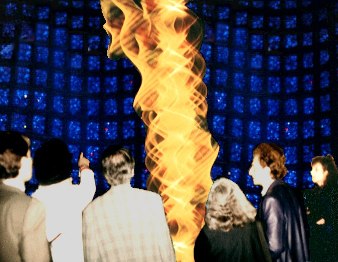
The rope set spinning in
this installation would be invisible in the near darkness of the Great Hall
if it were not for the fact that it will be illuminated by an intensely powerful
arc lamp bounced off a mylar mirror suspended from the ceiling.
There are no time constraints,
changes occur whenever someone interacts with the installation.
A light sculpture on this
scale becomes a powerful aeolian harp, producing an eerie, ethereal sound which
rises and falls with the varying rope speed.
Changes to the color and
rope speed are via MIDI and specialised controllers. The quiescent state will
be the rope moving at a moderate speed in a random colour. The height of the
installation is approximately 8 metres.

Winning Proposal
for Lightforms '98, Great Hall, New York Hall of Science © Paul Friedlander
1997.


home
page | Zip Art | gallery
guide | visual music





* Mass (weight)
of light can be calculated from E = mc2. The amount of solar energy falling
on the entire surface of the earth is 8 kilograms / second. By comparison a
super nova emits approximately 1 million million million tons per second.








